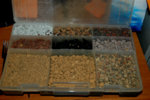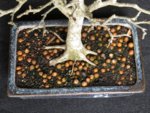My pro tip is to feed both the plant as well as the soil microbiome. I could write a book on the subject, but it can be distilled down to the following:
- the microbiome protects the plant in harsh conditions (drought, fires, cold, over watering).
- the microbiome defends the plant from pathogens, mainly the rootsystem.
- the microbiome provides the plant with nutrients.
Never, never ever forget what's really keeping yamadori alive in nature: that same microbiome.
Feed it fibers (bark, wood, paper, cardboard, hay, flax, hemp, oatmeal, you name it.. but never bread or other yeasted/fermented products.)
Feed it carbohydrates (honey, sugar, maple syrup, corn syrup, other sources of glucose, fructose, starches or sucrose).
Do this moderately though, a tablespoon per month at most.
Both are carbohydrate sources by the way, but they are used differently by microbes. Most bacteria suck at breaking down fibers and most fungi are too slow to eat sugars unless they poor down on them.
That same tablespoon can also act as a test: throw some of the stuff on the soil in spring, the biome will latch out and pull it back into the soil to turn it in mycelium (extending effective surface area), into bacteria producing a variety of chemicals and antibiotics, or feed the plant directly. Honey is processed within 14 days in a container with a healthy system. It doesn't evaporate, it's the microbes doing their job.
That combined approach, of using the right soil and providing the right conditions has caused a very high survival rate for conifers. Double flushes on single flush pines, during the first season in a pot. If restoration is the goal, then restore the entire system. I think we could do better than nature, since these basic elements are so readily available for us.
The importance of this is often being overlooked, something of less importance. But if a tree lives 150 years without applied nutrients and only from supportive bacteria and fungi, then it might be more important than the choice of substrate.
Interesting stuff about the Danish clay cat litter, it matches my observations here too. It holds a lot of water, almost detrimentally depending on the circumstances. Bougies don't like it and I have definitely over watered even in small mame size pots throughout summer. It blew me away I was seeing algae in our heat and wind with once a day watering. Next season they are going in akadama and lava mostly. Zeolite and cat litter seems to definitely be a mistake for Bougies, both hold lots of water.
I do like it though, especially for thirsty trees and grow out pots plus you can see if it is still holding water and you cna play with ratios anyway. Freezing isn't an issue for me though so I found that part quite interesting.
I'm a big fan of the clay litter. It's cheap and I can pick it up at local stores, six bags at a time! And it's pretty nice that it holds the water without leaking a lot. This means the substrate, even though it's coarse, still keeps the roots damp. I'm doing some tests with mixtures of the stuff, because of the large particle size. Perlite and lava rock are good combinations, 50/50 akadama/litter is working well too. It's problematic though when there's still organic soil in the rootball. Then it tends to get - and stay mushy, like with every other inorganic substrate.
Another downside is that pigeons, doves and every corvid in the area, seem to like it for breakfast. First they steal the moss, then they feast on the litter.



